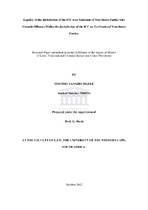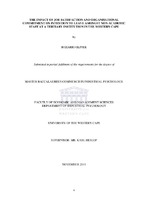| dc.description.abstract | Organizations are operating within a difficult economic environment and in the face of fierce world competition (George & Jones, 1992 cited in Ndlovu & Brijball Parumasur, 2005). To remain competitive globally and for economic reasons, Theron and Dodd (2011) postulate that organizations sporadically have to retrench workers. In order to reduce expenses as well as costs and losses to the organization, they have to restructure and reduce their headcount and the typical form of engaging in the restructuring is by means of downsizing. Makawatsakul and Kleiner (2003) posit that employee morale and loyalty tend to be the first unintended casualties of a downsizing strategy. The repercussions of downsizing is that it jeopardizes employees’ commitment
and morale to a large extent (Muthuvuloo 8Rose, 2005) and survivors thus experience lower job and organizational satisfaction (Baruch & Hind, 2000) as this creates insecurity, anxiety and uncertainty. Survivors are also often forced to make a sideway or downward move in their job, may experience a drop in pay and status, become stressed by the amount of work left by departing colleagues that they would now need to undertake and worry about the security of their new position in the organization (Chipunza & Berry 2010). In light of the above, the aim of the study was to investigate the organizational commitment of those employees who survived and remained with the retail organization following a downsizing process. For the purpose of this study a
quantitative, non probability convenience sampling design was utilized. The sample (N=150) comprised of both males and females from different ethnic groups. A self developed biographical questionnaire and the Organizational Commitment Questionnaire (OCQ) were used to gather data. Statistical analyses involved both descriptive and inferential statistics (the Pearson Product-Moment Correlation Coefficient, Multiple Regression Analysis and Analysis of Variance). The results of the study indicate that employees display below average levels of commitment to the organization. More specifically, a direct, positive relationship was found between normative and affective commitment. Furthermore, a statistically significant relationship was found between
affective and continuance commitment. Statistically significant relationships were found between the biographical characteristics namely, tenure, gender and age, and organizational commitment. Limitations of the current study are put forth and recommendations are made with respect to future research and for the organization. | en_US |




